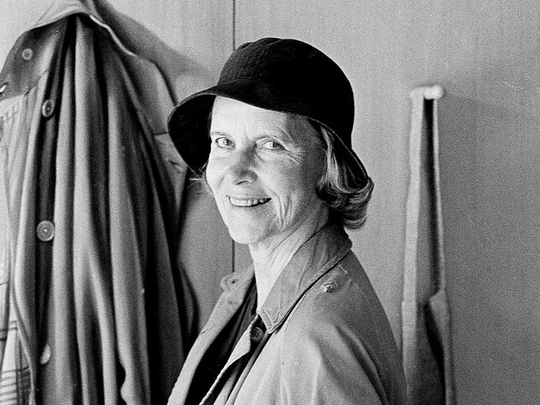
By Meryl Gordon, Grand Central Publishing, 516 pages, $28
It starts with the name. Why on earth would a grown woman go through life with the nickname Bunny?
Bunny Mellon, the wife of the financier and philanthropist Paul Mellon, was christened Rachel, after her mother, but until her death in 2014 at the age of 103, she was known by the endearment her nanny gave her. (Men, of course, have been bestowing their sons with abstruse monikers for generations: Trip, it turns out, is not a sobriquet for a clumsy child; it’s shorthand for “III,” as in Thurston Howell.)
In such circles as the Howells’s and Mellons’s, nicknames are passwords into a closed society that, like the mob, runs on its own rules and customs. Nobody messed with Anthony “Whack-Whack” Indelicato or Antonio “Bootsie” Tomasulo, and the same rule applies in higher society. Childish names signal cliquishness and the immunity to ridicule that comes with money and power. “I don’t really come by to pray,” Mellon once told the rector of an Episcopalian church in the Norman medieval style that she financed and helped design. “I come in to talk with God because he’s a dear, dear friend of mine.”
Bunny Mellon: The Life of an American Style Legend, by Meryl Gordon, is an astute and intriguing portrait of a celebrity who wasn’t famous outside her own milieu. Mellon was a gifted gardener with princely means and infallible taste: Her close friend Jacqueline Kennedy asked her to redesign the White House Rose Garden. This well-bred heiress was both shockingly extravagant and studiously understated: Her aesthetic motto was “nothing should be noticed.”
Today, Mellon’s world is, needless to say, a vanishing one, and there is no clearer sign of it than this Edith Whartonish twist: Rickie Niceta, who is married to Mellon’s grandson, Thomas, is Melania Trump’s White House social secretary. (Insert joke about no-show jobs here.)
Like Brooke Astor, the subject of one of Gordon’s previous biographies, Mellon is possibly remembered less for what she did than for what was done to her in her dotage. Astor, who was 105 when she died in 2007, had one son, Anthony Marshall, who was accused by one of his own sons of elder abuse. After a lollapalooza trial, Marshall was convicted of larceny in 2009 and spent a few months in prison before his death in 2014. The Astors’ three-generation psychodrama made for a juicier book.
But Mellon also made headlines late in life. When John Edwards’s 2008 presidential bid was derailed by a sex-and-money scandal, it came out that Bunny had given him upwards of $3 million. She was so smitten that she funnelled another $725,000 into a slush fund for the candidate’s private use; the campaign used it to keep his mistress, Rielle Hunter, and their baby secret. Mellon wasn’t upset by her protege’s infidelity to his dying wife, Elizabeth; however she did balk when the disgraced Edwards asked her for millions to create an antipoverty foundation.
But she felt no guilt about the entanglement. One of her closest confidants, a North Carolina interior designer named Bryan Huffman, had introduced her to Edwards. Long after the trial, Bunny would reminisce with him about their covert conspiracy, saying, “Didn’t we have fun?”
She did have fun, but not as much as one would expect.
Bunny Mellon was written with the Mellon family’s cooperation, so it’s not steaming with leering conjecture. Mostly, the biography documents unsettling contradictions. Mellon lavished attention on the Kennedys’ daughter, Caroline, but sent her own only son, Tuffy (Stacy Barcroft Lloyd III), away to boarding school when he was 8. Her lifestyle, which included houses in Antigua, Paris, New York, Virginia and Cape Cod, cost about $20 million a year. She would send the Mellons’ private plane around the country to deliver fresh flowers and vegetables to friends from their 5,000-acre farm in Upperville, Virginia. She scoured the beach at her estate in Cape Cod for the perfect clamshell in which to encase a gift of pearl earrings for Jackie Kennedy. (She considered Tiffany’s signature blue box “declasse.”)
But she could callously jettison old friends, including Paul Leonard, a stage designer and decorator; she dropped him when he got married. When he was dying of cancer, Leonard asked his old friend and patroness for money for his wife and daughter. Mellon did not respond. Her story is a reminder that the wealthy are often most generous to the friends who need it the least.
Bunny Mellon was above all a product of her generation and class, a debutante raised to run a grand household who found her true calling outdoors in the garden. Born into privilege (her father was a Listerine heir), she went to the elite Foxcroft private school, but her father drew the line at college. She divorced her first husband, Stacy Barcroft Lloyd Jr, in 1948, because she suspected him of infidelity and turned instead to their friend and neighbour, Paul Mellon, a recent widower who was at one point the fifth-richest man in the world and even more prone to running around.
The marriage was strained and at times rocky — Paul, who died in 1999, didn’t go to many pains to hide his longtime mistress. One of the chief mysteries Gordon raises but leaves unsolved is why he and Bunny ever married in the first place. In his memoir, Reflections in a Silver Spoon, Paul writes rather chillingly that the couple “have been careful to allow each other to develop our own interests.”
Together, they collected art and entertained presidents and British royalty, but they were often apart. He bred race horses; she cultivated miniature topiary trees. He was analysed by Jung; she consulted psychics. Most of all, Bunny Mellon devoted her attention to landscaping, interior design, jewellery and haute couture. Hubert de Givenchy was an intimate friend. She was a perfectionist — she asked Cristobal Balenciaga to design her gardening clothes — with an eye for the just-so imperfection, be it a frayed antique chair or an overgrown garden path.
She led an exquisitely cocooned life, but tragedy struck in 2000 when her daughter, Eliza, was hit by a truck and suffered severe brain damage and paralysis. She died in 2008. When Mellon died six years later, the auction of her possessions was the sale of the decade. It took Sotheby’s five days and a four-volume catalogue to sell off the vast quantities of art, jewellery, porcelain and furniture. Most of the $218 million in proceeds went to her most cherished legacy, a horticultural research centre called the Oak Spring Garden Library, located on the Mellon farm.
Niceta said she burst into tears when she saw her grandmother-in-law and mentor’s pharaonic stockpile of precious watches, broaches, bracelets, purses and rings. “I felt like there had been a true hole in her heart, and she was desperate to fill it,” Niceta told Gordon. “She tried to fill the void by buying all that stuff.”
–New York Times News Service
Alessandra Stanley was the television critic for the New York Times.









